Simulation of Hospital Waste Supply Chain in the Context of Industry 4.0—A Systematic Literature Review
Abstract
1. Introduction
2. Literature Review
2.1. Industry 4.0
2.2. Healthcare Waste Management
2.3. Hybrid Simulation
2.4. Hospital Supply Chain in the Context of Industry 4.0
3. Materials and Methods
Study Search
4. Results
4.1. Publications by Year
4.2. Documents by Type
4.3. Journals
4.4. Documents by Country or Territory
4.5. Documents by Subject Area
4.6. Keywords Analysis
5. Discussion
5.1. Generation Rate of Medical Waste
5.2. Impact of COVID-19 Pandemic on Medical Waste Management and Environment
5.3. Implications of Medical Waste for the Environment and Public Health
5.4. Medical Waste Management Process
5.5. Research Questions
6. Conclusions and Limitations
- (i)
- What the economic impact is in situations of good medical waste management;
- (ii)
- The existence of more practical cases in which simulation has been used as a tool for improving the performance of supply chains and the economic results and comparison of the situation before and after using simulation;
- (iii)
- The environmental impacts caused by medical waste and what hybrid simulation can do to improve sustainability.
Author Contributions
Funding
Conflicts of Interest
References
- Kenny, C.; Priyadarshini, A. Review of Current Healthcare Waste Management Methods and Their Effect on Global Health. Healthcare 2021, 9, 284. [Google Scholar] [CrossRef] [PubMed]
- Ranjbari, M.; Shams Esfandabadi, Z.; Shevchenko, T.; Chassagnon-Haned, N.; Peng, W.; Tabatabaei, M.; Aghbashlo, M. Mapping Healthcare Waste Management Research: Past Evolution, Current Challenges, and Future Perspectives towards a Circular Economy Transition. J. Hazard. Mater. 2022, 422, 126724. [Google Scholar] [CrossRef] [PubMed]
- Dixit, A.; Routroy, S.; Dubey, S.K. A Systematic Literature Review of Healthcare Supply Chain and Implications of Future Research. Int. J. Pharm. Healthc. Mark. 2019, 13, 405–435. [Google Scholar] [CrossRef]
- Chauhan, A.; Singh, S.P. Selection of Healthcare Waste Disposal Firms Using a Multi-Method Approach. J. Environ. Manag. 2021, 295, 113117. [Google Scholar] [CrossRef] [PubMed]
- Erdem, M. Designing a Sustainable Logistics Network for Hazardous Medical Waste Collection a Case Study in COVID-19 Pandemic. J. Clean. Prod. 2022, 376, 134192. [Google Scholar] [CrossRef] [PubMed]
- Andeobu, L.; Wibowo, S.; Grandhi, S. Medical Waste from COVID-19 Pandemic—A Systematic Review of Management and Environmental Impacts in Australia. Int. J. Environ. Res. Public Health 2022, 19, 1381. [Google Scholar] [CrossRef] [PubMed]
- Bolan, S.; Padhye, L.P.; Kumar, M.; Antoniadis, V.; Sridharan, S.; Tang, Y.; Singh, N.; Hewawasam, C.; Vithanage, M.; Singh, L.; et al. Review on Distribution, Fate, and Management of Potentially Toxic Elements in Incinerated Medical Wastes. Environ. Pollut. 2023, 321, 121080. [Google Scholar] [CrossRef] [PubMed]
- Das, A.K.; Islam, M.N.; Billah, M.M.; Sarker, A. COVID-19 Pandemic and Healthcare Solid Waste Management Strategy—A Mini-Review. Sci. Total Environ. 2021, 778, 146220. [Google Scholar] [CrossRef]
- Goodarzian, F.; Ghasemi, P.; Gunasekaran, A.; Labib, A. A fuzzy sustainable model for COVID-19 medical waste supply chain network. Fuzzy Optim. Decis. Mak. 2024, 23, 93–127. [Google Scholar] [CrossRef]
- Xin, Y. Comparison of Hospital Medical Waste Generation Rate Based on Diagnosis-Related Groups. J. Clean. Prod. 2015, 100, 202–207. [Google Scholar] [CrossRef]
- Singh, N.; Ogunseitan, O.A.; Tang, Y. Medical Waste: Current Challenges and Future Opportunities for Sustainable Management. Crit. Rev. Environ. Sci. Technol. 2022, 52, 2000–2022. [Google Scholar] [CrossRef]
- Lee, S.M.; Lee, D.H. Effective Medical Waste Management for Sustainable Green Healthcare. Int. J. Environ. Res. Public Health 2022, 19, 14820. [Google Scholar] [CrossRef] [PubMed]
- Zonta, T.; da Costa, C.A.; da Rosa Righi, R.; de Lima, M.J.; da Trindade, E.S.; Li, G.P. Predictive Maintenance in the Industry 4.0: A Systematic Literature Review. Comput. Ind. Eng. 2020, 150, 106889. [Google Scholar] [CrossRef]
- Oláh, J.; Aburumman, N.; Popp, J.; Khan, M.A.; Haddad, H.; Kitukutha, N. Impact of Industry 4.0 on Environmental Sustainability. Sustainability 2020, 12, 4674. [Google Scholar] [CrossRef]
- Miśkiewicz, R.; Wolniak, R. Practical Application of the Industry 4.0 Concept in a Steel Company. Sustainability 2020, 12, 5776. [Google Scholar] [CrossRef]
- Vaidya, S.; Ambad, P.; Bhosle, S. Industry 4.0—A Glimpse. Procedia Manuf. 2018, 20, 233–238. [Google Scholar] [CrossRef]
- Müller, J.M.; Kiel, D.; Voigt, K.I. What Drives the Implementation of Industry 4.0? The Role of Opportunities and Challenges in the Context of Sustainability. Sustainability 2018, 10, 247. [Google Scholar] [CrossRef]
- Sima, V.; Gheorghe, I.G.; Subić, J.; Nancu, D. Influences of the Industry 4.0 Revolution on the Human Capital Development and Consumer Behavior: A Systematic Review. Sustainability 2020, 12, 4035. [Google Scholar] [CrossRef]
- Ruiz-Sarmiento, J.R.; Monroy, J.; Moreno, F.A.; Galindo, C.; Bonelo, J.M.; Gonzalez-Jimenez, J. A Predictive Model for the Maintenance of Industrial Machinery in the Context of Industry 4.0. Eng. Appl. Artif. Intell. 2020, 87, 103289. [Google Scholar] [CrossRef]
- Windfeld, E.S.; Brooks, M.S.L. Medical Waste Management—A Review. J. Environ. Manag. 2015, 163, 98–108. [Google Scholar] [CrossRef]
- Prem Ananth, A.; Prashanthini, V.; Visvanathan, C. Healthcare Waste Management in Asia. Waste Manag. 2010, 30, 154–161. [Google Scholar] [CrossRef]
- Ouyang, L.; Zhu, Y.; Zheng, W.; Yan, L. An Information Fusion FMEA Method to Assess the Risk of Healthcare Waste. J. Manag. Sci. Eng. 2021, 6, 111–124. [Google Scholar] [CrossRef]
- Liu, S.; Zhang, J.; Niu, B.; Liu, L.; He, X. A Novel Hybrid Multi-Criteria Group Decision-Making Approach with Intuitionistic Fuzzy Sets to Design Reverse Supply Chains for COVID-19 Medical Waste Recycling Channels. Comput. Ind. Eng. 2022, 169, 108228. [Google Scholar] [CrossRef] [PubMed]
- Ghali, H.; Cheikh, A.B.; Bhiri, S.; Bouzgarrou, L.; Rejeb, M.B.; Gargouri, I.; Latiri, H.S. Health and Environmental Impact of Hospital Wastes: Systematic Review. Dubai Med. J. 2023, 6, 67–80. [Google Scholar] [CrossRef]
- Clauson, K.A.; Breeden, E.A.; Davidson, C.; Mackey, T.K. Leveraging Blockchain Technology to Enhance Supply Chain Management in Healthcare: An Exploration of Challenges and Opportunities in the Health Supply Chain. Blockchain Healthc. Today 2018, 1, 1–12. [Google Scholar] [CrossRef]
- Torkashvand, J.; Pasalari, H.; Jonidi-Jafari, A.; Kermani, M.; Nasri, O.; Farzadkia, M. Medical Waste Management in Iran and Comparison with Neighbouring Countries. Int. J. Environ. Anal. Chem. 2022, 102, 2805–2818. [Google Scholar] [CrossRef]
- Hsu, P.F.; Wu, C.R.; Li, Y.T. Selection of Infectious Medical Waste Disposal Firms by Using the Analytic Hierarchy Process and Sensitivity Analysis. Waste Manag. 2008, 28, 1386–1394. [Google Scholar] [CrossRef]
- Olabi, A.G.; Shehata, N.; Obaideen, K.; Sayed, E.T.; Mahmoud, M.; AlMallahi, M.N.; Abdelkareem, M.A. COVID-19: Medical Waste Management, Impact on Sustainable Development Goals, and Bibliometric Analysis. Chem. Eng. Technol. 2024, 47, 4–19. [Google Scholar] [CrossRef]
- Le, H.T.; Quoc, K.L.; Nguyen, T.A.; Dang, K.T.; Vo, H.K.; Luong, H.H.; Le Van, H.; Gia, K.H.; Cao Phu, L.V.; Nguyen Truong Quoc, D.; et al. Medical-Waste Chain: A Medical Waste Collection, Classification and Treatment Management by Blockchain Technology. Computers 2022, 11, 113. [Google Scholar] [CrossRef]
- Erboz, G. How to Define Industry 4.0: Main Pillars Of Industry 4.0. Manag. Trends Dev. Enterp. Glob. Era 2017, 761, 761–767. [Google Scholar]
- Xu, J.; Huang, E.; Hsieh, L.; Lee, L.H.; Jia, Q.S.; Chen, C.H. Simulation Optimization in the Era of Industrial 4.0 and the Industrial Internet. J. Simul. 2016, 10, 310–320. [Google Scholar] [CrossRef]
- Palmer, G.I.; Tian, Y. Implementing Hybrid Simulations That Integrate DES+SD in Python. J. Simul. 2023, 17, 240–256. [Google Scholar] [CrossRef]
- Scheidegger, A.P.G.; Pereira, T.F.; de Oliveira, M.L.M.; Banerjee, A.; Montevechi, J.A.B. An Introductory Guide for Hybrid Simulation Modelers on the Primary Simulation Methods in Industrial Engineering Identified through a Systematic Review of the Literature. Comput. Ind. Eng. 2018, 124, 474–492. [Google Scholar] [CrossRef]
- Brailsford, S.C.; Eldabi, T.; Kunc, M.; Mustafee, N.; Osorio, A.F. Hybrid Simulation Modelling in Operational Research: A State-of-the-Art Review. Eur. J. Oper. Res. 2019, 278, 721–737. [Google Scholar] [CrossRef]
- Ahsan, M.M.; Siddique, Z. Industry 4.0 in Healthcare: A Systematic Review. Int. J. Inf. Manag. Data Insights 2022, 2, 100079. [Google Scholar] [CrossRef]
- Fanta, G.B.; Pretorius, L.; Nunes, B. Enabling Circular Economy in Healthcare Using Industry 4.0 Digital Technologies. In Proceedings of the 30th International Conference of the International Association for Management of Technology, IAMOT 2021—MOT for the World of the Future, Cairo, Egypt, 19–23 September 2021; pp. 1111–1123. [Google Scholar] [CrossRef]
- Jayaraman, P.P.; Forkan, A.R.M.; Morshed, A.; Haghighi, P.D.; Kang, Y. Bin Healthcare 4.0: A Review of Frontiers in Digital Health. Wiley Interdiscip. Rev. Data Min. Knowl. Discov. 2020, 10, 1–23. [Google Scholar] [CrossRef]
- Paul, S.; Riffat, M.; Yasir, A.; Mahim, M.N.; Sharnali, B.Y.; Naheen, I.T.; Rahman, A.; Kulkarni, A. Industry 4.0 Applications for Medical/Healthcare Services. J. Sens. Actuator Netw. 2021, 10, 43. [Google Scholar] [CrossRef]
- Shah, R.; Chircu, A. Iot and Ai in Healthcare: A Systematic Literature Review. Issues Inf. Syst. 2018, 19, 33–41. [Google Scholar] [CrossRef]
- Mengist, W.; Soromessa, T.; Legese, G. Method for Conducting Systematic Literature Review and Meta-Analysis for Environmental Science Research. MethodsX 2020, 7, 100777. [Google Scholar] [CrossRef]
- Donthu, N.; Kumar, S.; Mukherjee, D.; Pandey, N.; Lim, W.M. How to Conduct a Bibliometric Analysis: An Overview and Guidelines. J. Bus. Res. 2021, 133, 285–296. [Google Scholar] [CrossRef]
- Page, M.J.; McKenzie, J.E.; Bossuyt, P.M.; Boutron, I.; Hoffmann, T.C.; Mulrow, C.D.; Shamseer, L.; Tetzlaff, J.M.; Akl, E.A.; Brennan, S.E.; et al. The PRISMA 2020 Statement: An Updated Guideline for Reporting Systematic Reviews. BMJ 2021, 372, n71. [Google Scholar] [CrossRef]
- Sungkono, K.R.; Sarno, R.; Onggo, B.S.; Septiyanto, A.F. Optimising Waste Man-Agement Collaboration Processes Using Hybrid Modelling. Int. J. Simul. Model. 2024, 23, 53–64. [Google Scholar] [CrossRef]
- Liu, H.; Yao, Z.; Meijer, S. Research on Transportation Management Model of COVID-19 Medical Waste: A Case Study in Beijing, China. Environ. Sci. Pollut. Res. Int. 2023, 30, 120284–120299. [Google Scholar] [CrossRef] [PubMed]
- Arifin, M.; Hidaytulloh, S.; Sari, S.K. Discrete Cuckoo Search Algorithm in Scheduling Dynamic Route of Medical and Non-Medical Waste Transportation at Regional-Based Health Facilities during the COVID-19 Pandemic. AIP Conf. Proc. 2023, 2693, 030022. [Google Scholar] [CrossRef]
- Nosrati-Abarghooee, S.; Sheikhalishahi, M.; Nasiri, M.M.; Gholami-Zanjani, S.M. Designing Reverse Logistics Network for Healthcare Waste Management Considering Epidemic Disruptions under Uncertainty. Appl. Soft Comput. 2023, 142, 110372. [Google Scholar] [CrossRef]
- Shaju, S.; George, T.; Francis, J.K.; Joseph, M.; Thomas, M.J. Conceptual Design and Simulation Study of an Autonomous Indoor Medical Waste Collection Robot. IAES Int. J. Robot. Autom. 2023, 12, 29–40. [Google Scholar] [CrossRef]
- Maziya, F.B.; Luthi, R.S.; Iresha, F.M.; Abidin, A.U. The Influence of Pandemic COVID-19 on Hazardous Waste Management from Hospital A in Yogyakarta. Proc. IOP Conf. Ser. Earth Environ. Sci. 2023, 1257, 012014. [Google Scholar]
- Xiao, H.; Ma, C.; Gao, H.; Gao, Y.; Xue, Y. Green Transformation of Anti-Epidemic Supplies in the Post-Pandemic Era: An Evolutionary Approach. Int. J. Environ. Res. Public Health 2022, 19, 6011. [Google Scholar] [CrossRef]
- Sungkono, K.R.; Dewa Prakasa, T.A.; Hermawan, A.R.; Bhamakerti, G.A.; Sarno, R. Optimizing Time and Cost Activity Based on Discrete Event Simulation with Multi-Objective Optimization Method by Ratio Analysis (MOORA). In Proceedings of the Proceedings—ICACSIS 2022: 14th International Conference on Advanced Computer Science and Information Systems; Institute of Electrical and Electronics Engineers Inc.: New York, NY, USA, 2022; pp. 53–58. [Google Scholar]
- Liu, Z.; Liu, T.; Liu, X.; Wei, A.; Wang, X.; Yin, Y.; Li, Y. Research on Optimization of Healthcare Waste Management System Based on Green Governance Principle in the COVID-19 Pandemic. Int. J. Environ. Res. Public Health 2021, 18, 5316. [Google Scholar] [CrossRef]
- Aydın, N. A Comprehensive Waste Management Simulation Model for the Assessment of Waste Segregation in the Health Sector. Environ. Eng. Manag. J. 2021, 20, 1731–1738. [Google Scholar] [CrossRef]
- Peyman, M.; Li, Y.; Tordecilla, R.D.; Copado-Mendez, P.J.; Juan, A.A.; Xhafa, F. Waste Collection of Medical Items under Uncertainty Using Internet of Things and City Open Data Repositories: A Simheuristic Approach. In Proceedings of the Winter Simulation Conference; Institute of Electrical and Electronics Engineers Inc.: New York, NY, USA, 2021. [Google Scholar]
- Mulyadi, A.; Arvitrida, N.I. Managing Medical Waste during COVID-19 Outbreak: A Simulation Approach. Proc. Int. Conf. Ind. Eng. Oper. Manag. 2021, 379–390. [Google Scholar] [CrossRef]
- Irfa’i, M.; Arifin, A.; Kriswandana, F.; Thohari, I. The Design of Medical Waste Treat-Ment in Public Health Center (MWT-P) for Reducing Total Bacteria Count in Banjarbaru. J. Kesehat. Lingkung. 2020, 12, 254–261. [Google Scholar] [CrossRef]
- Liu, W.; Guo, J.; Yao, F.; Chen, D. Adaptive Protocol Generation for Group Collaborative in Smart Medical Waste Transportation. Futur. Gener. Comput. Syst. 2020, 110, 167–180. [Google Scholar] [CrossRef]
- Liu, Z.; Li, Z.; Chen, W.; Zhao, Y.; Yue, H.; Wu, Z. Path Optimization of Medical Waste Transport Routes in the Emergent Public Health Event of COVID-19: A Hybrid Optimization Algorithm Based on the Immune–Ant Colony Algorithm. Int. J. Environ. Res. Public Health 2020, 17, 5831. [Google Scholar] [CrossRef] [PubMed]
- Abdelall, S.; Baroud, D.; Alalamy, S.; Alrass, I.; Agha, S. The Use of Discrete Event Simulation for Optimal Performance of Blood Banks (A Case Study of Al-Shifa Central Blood Bank). In Proceedings of the 2020 International Conference on Assistive and Rehabilitation Technologies, iCareTech 2020; Institute of Electrical and Electronics Engineers Inc.: New York, NY, USA, 2020; pp. 36–40. [Google Scholar]
- Daoud, R.; Kammoun, M.; Hachicha, W. Solving a Routing Problem of Collect Infectious Healthcare Waste with Stochastic Demand: Case of Sfax Governorate in Tunisia. World Rev. Intermodal Transp. Res. 2020, 9, 297–311. [Google Scholar] [CrossRef]
- Mantzaras, G.; Voudrias, E.A. An Optimization Model for Collection, Haul, Transfer, Treatment and Disposal of Infectious Medical Waste: Application to a Greek Region. Waste Manag. 2017, 69, 518–534. [Google Scholar] [CrossRef] [PubMed]
- Al-Khatib, I.A.; Eleyan, D.; Garfield, J. A System Dynamics Approach for Hospital Waste Management in a City in a Developing Country: The Case of Nablus, Palestine. Environ. Monit. Assess. 2016, 188, 503. [Google Scholar] [CrossRef] [PubMed]
- Eduardo, A.H.A.; Mendes, A.A.; Binotto, C.C.S.; Tognoli, S.H.; Tucci, A.M.G.B. Scenario for a Simulation of Health Services’ Waste: A Methodological Study. Online Braz. J. Nurs. 2016, 15, 611–616. [Google Scholar] [CrossRef]
- Taslimi, M.; Batta, R.; Kwon, C. Medical Waste Collection Considering Transportation and Storage Risk. Comput. Oper. Res. 2020, 120, 104966. [Google Scholar] [CrossRef]
- Janik-Karpinska, E.; Brancaleoni, R.; Niemcewicz, M.; Wojtas, W.; Foco, M.; Podogrocki, M.; Bijak, M. Healthcare Waste—A Serious Problem for Global Health. Healthcare 2023, 11, 242. [Google Scholar] [CrossRef] [PubMed]
- Bokhoree, C.; Beeharry, Y.; Makoondlall-Chadee, T.; Doobah, T.; Soomary, N. Assessment of Environmental and Health Risks Associated with the Management of Medical Waste in Mauritius. APCBEE Procedia 2014, 9, 36–41. [Google Scholar] [CrossRef]
- Tushar, S.R.; Alam MF, B.; Bari, A.M.; Karmaker, C.L. Assessing the Challenges to Medical Waste Management during the COVID-19 Pandemic: Implications for the Environmental Sustainability in the Emerging Economies. Socioecon. Plan. Sci. 2023, 87, 101513. [Google Scholar] [CrossRef] [PubMed]
- Kuntari, N.A.N.; Ulfa, M.; Jamal, A. The Impact of COVID-19 Pandemic on Hospital Waste Management: A Bibliometric Analysis. Avicenna J. Environ. Health Eng. 2023, 10, 110–119. [Google Scholar] [CrossRef]
- Sarkodie, S.A.; Owusu, P.A. Impact of COVID-19 Pandemic on Waste Management. Environ. Dev. Sustain. 2021, 23, 7951–7960. [Google Scholar] [CrossRef]
- Chew, X.Y.; Khaw, K.W.; Alnoor, A.; Ferasso, M.; Al Halbusi, H.; Muhsen, Y.R. Circular Economy of Medical Waste: Novel Intelligent Medical Waste Management Framework Based on Extension Linear Diophantine Fuzzy FDOSM and Neural Network Approach. Environ. Sci. Pollut. Res. 2023, 30, 60473–60499. [Google Scholar] [CrossRef] [PubMed]
- Nosheen, F.; Malik, N.; Mehmood, Z.; Jabeen, F.; Mahmood, A.; Ibrahim, M.; Bokhari, A.; Mubashir, M.; Chuah, L.F.; Show, P.L. Biomedical Waste Management Associated with Infectious Diseases among Health Care Professionals in Apex Hospitals of a Typical South Asian City. Environ. Res. 2022, 215, 114240. [Google Scholar] [CrossRef] [PubMed]
- Meleko, A.; Tesfaye, T.; Henok, A. Assessment of Healthcare Waste Generation Rate and Its Management System in Health Centers of Bench Maji Zone. Ethiop. J. Health Sci. 2018, 28, 125–134. [Google Scholar] [CrossRef] [PubMed]
- Attrah, M.; Elmanadely, A.; Akter, D.; Rene, E.R. A Review on Medical Waste Management: Treatment, Recycling, and Disposal Options. Environments 2022, 9, 146. [Google Scholar] [CrossRef]
- Gao, J.; Li, H.; Wu, J.; Lyu, J.; Tan, Z.; Jin, Z. Routing Optimisation of Urban Medical Waste Recycling Network Considering Differentiated Collection Strategy and Time Windows. Sci. Program. 2021, 2021, 5523910. [Google Scholar] [CrossRef]
- Babaee Tirkolaee, E.; Aydın, N.S. A Sustainable Medical Waste Collection and Transportation Model for Pandemics. Waste Manag. Res. 2021, 39, 34–44. [Google Scholar] [CrossRef]
- Çelik, S.; Peker, İ.; Gök-Kısa, A.C.; Büyüközkan, G. Multi-Criteria Evaluation of Medical Waste Management Process under Intuitionistic Fuzzy Environment: A Case Study on Hospitals in Turkey. Socioecon. Plan. Sci. 2023, 86, 101499. [Google Scholar] [CrossRef]
- Amariglio, A.; Depaoli, D. Waste Management in an Italian Hospital’s Operating Theatres: An Observational Study. Am. J. Infect. Control 2021, 49, 184–187. [Google Scholar] [CrossRef]
- Cai, X.; Du, C. Thermal Plasma Treatment of Medical Waste. Plasma Chem. Plasma Process. 2021, 41, 1–46. [Google Scholar] [CrossRef]
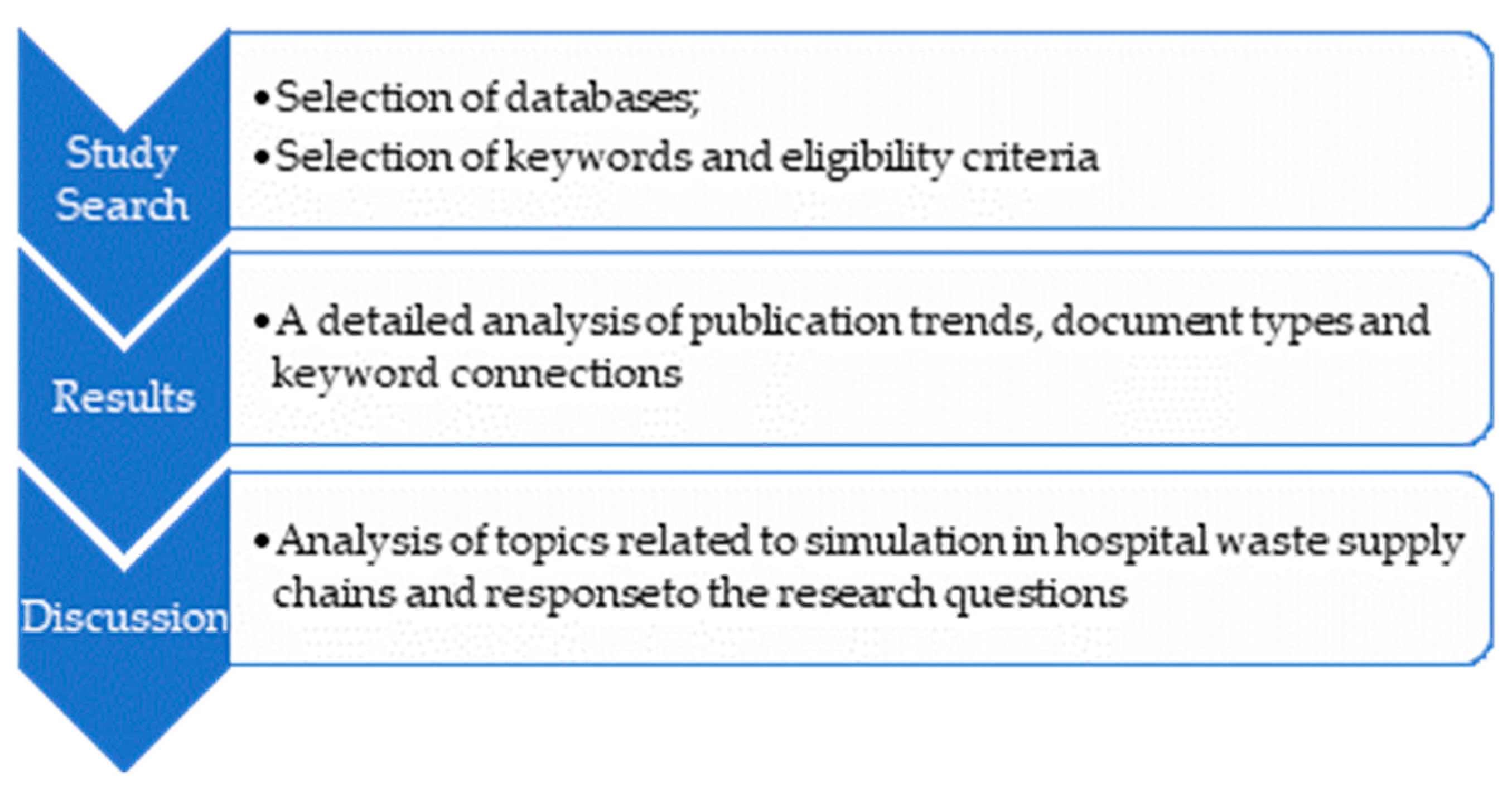
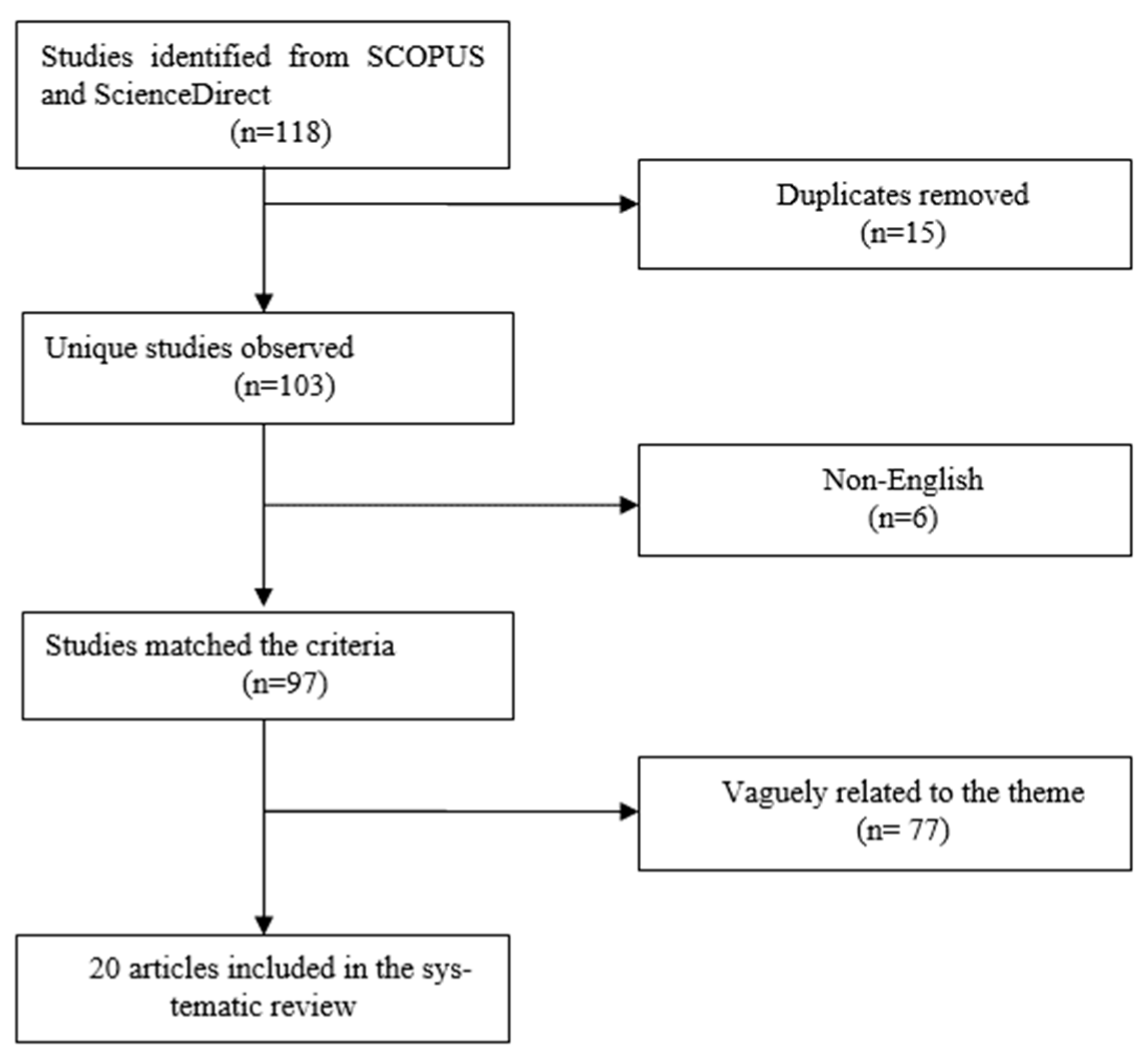
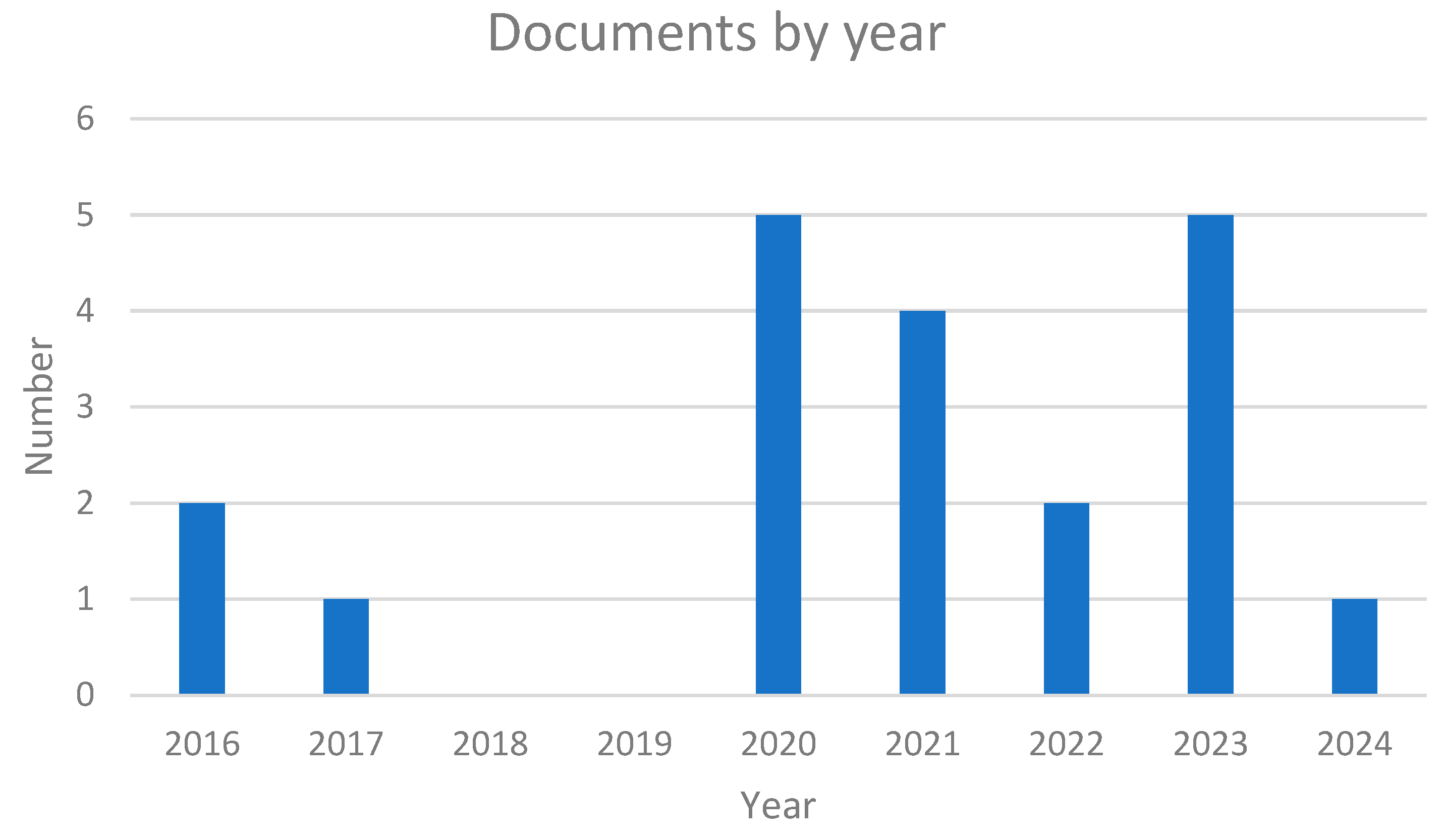
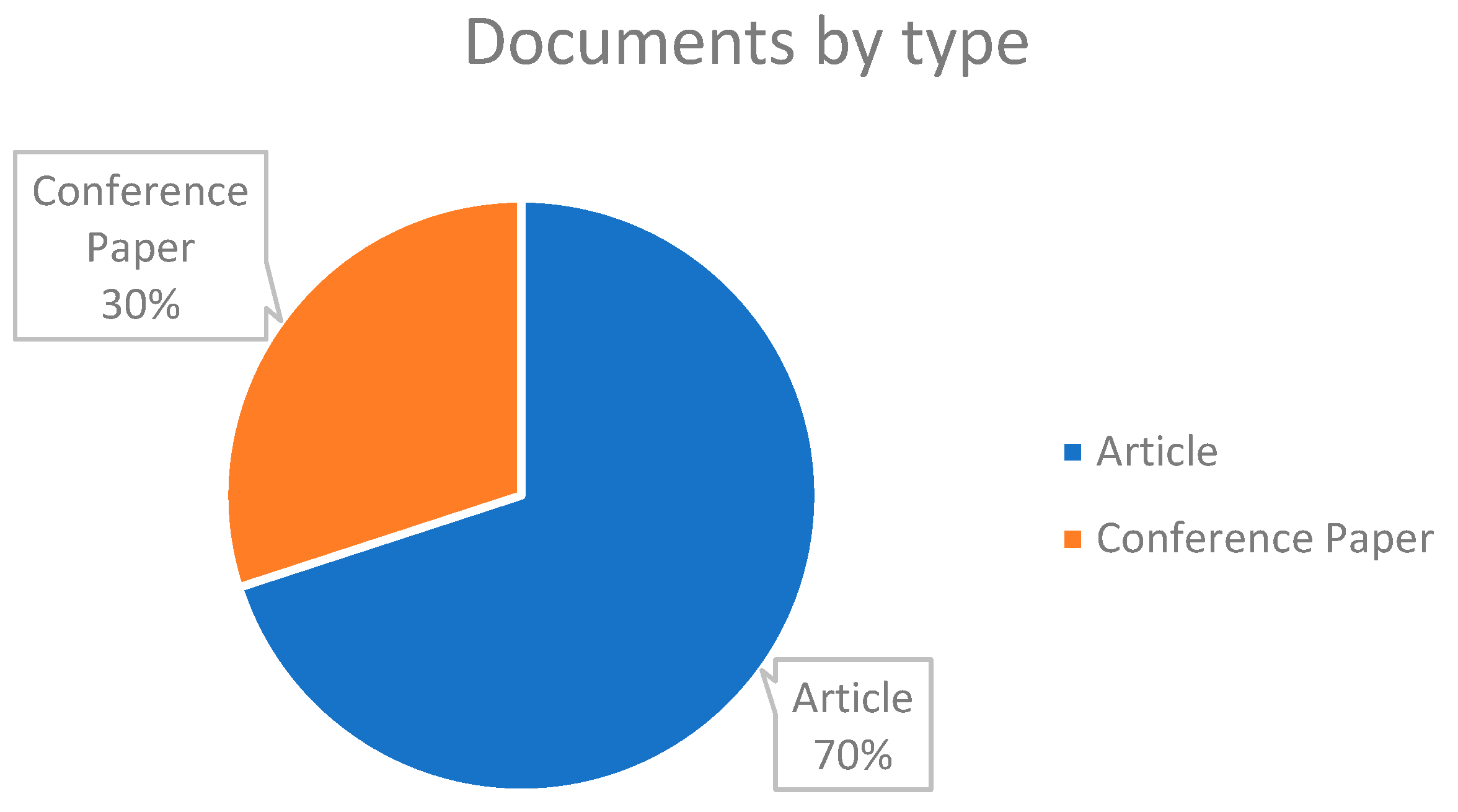
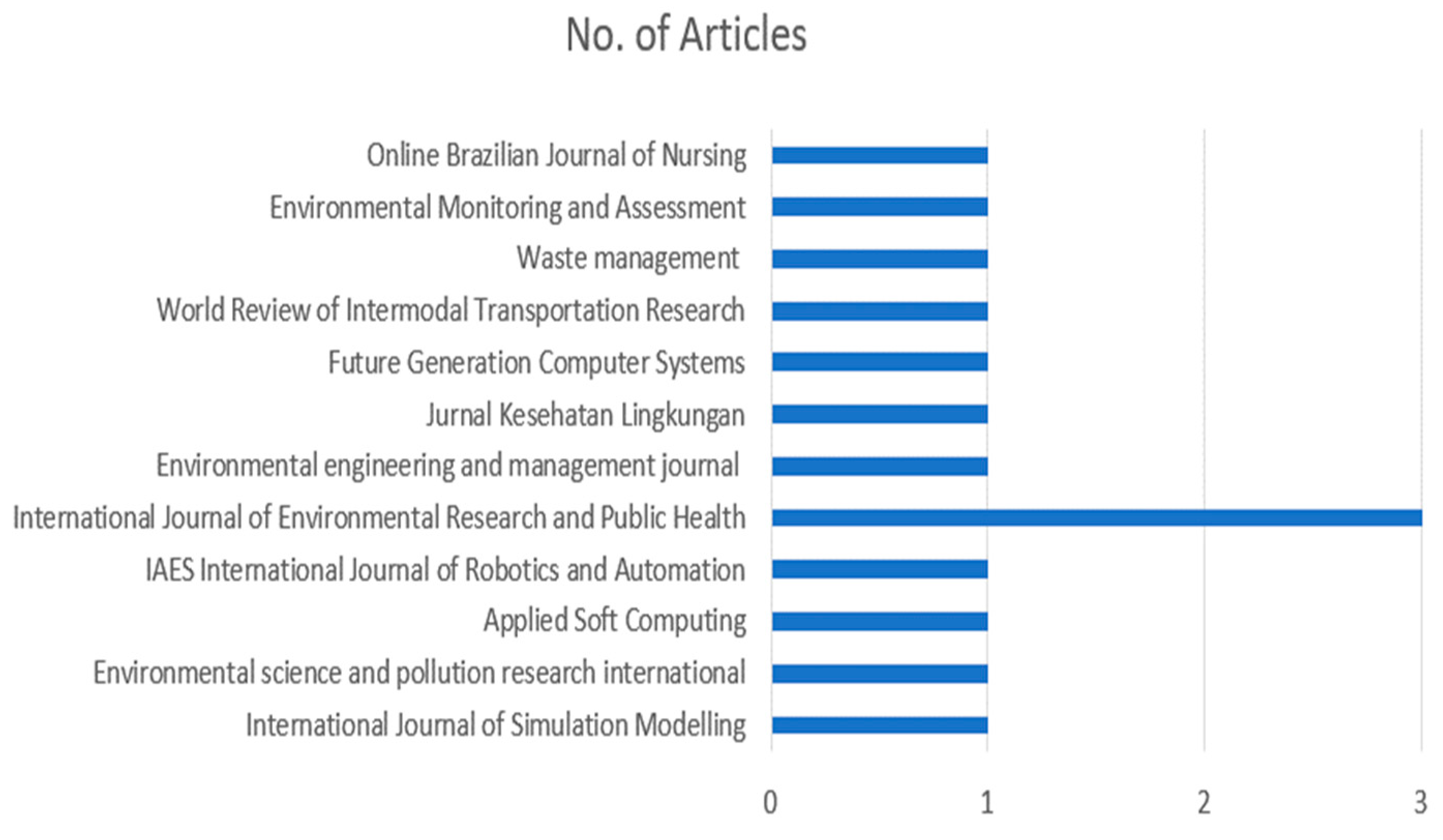
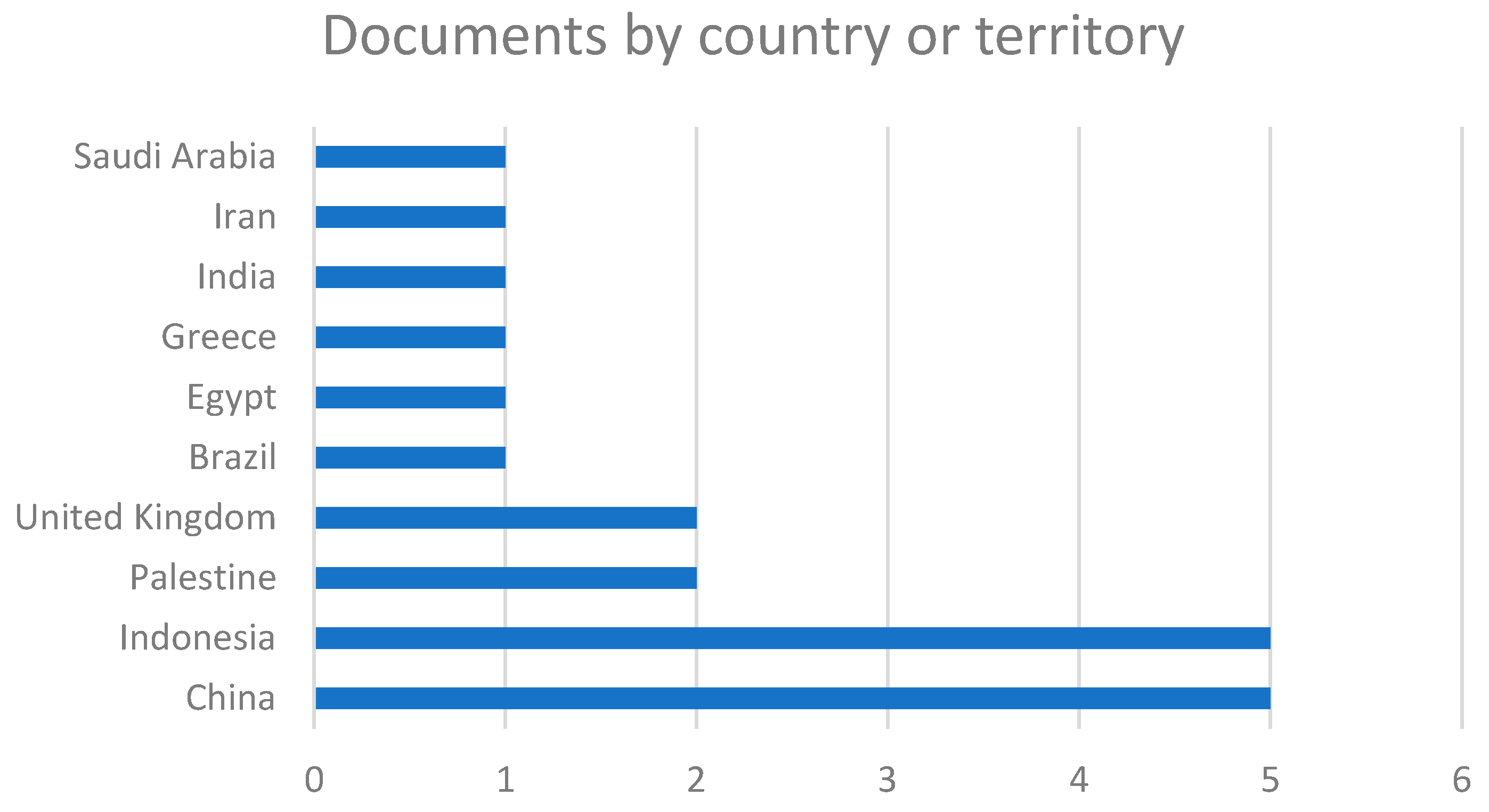
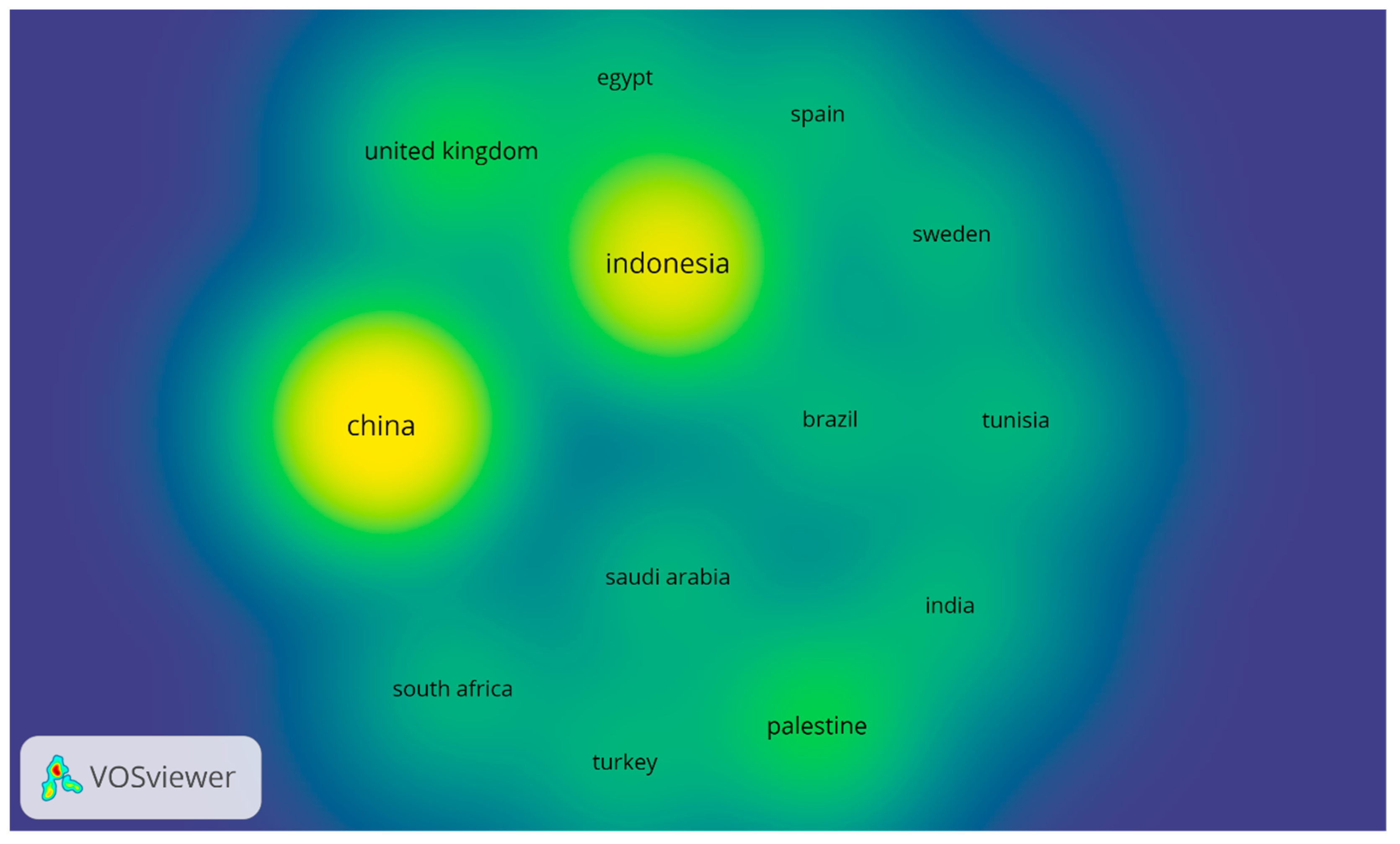
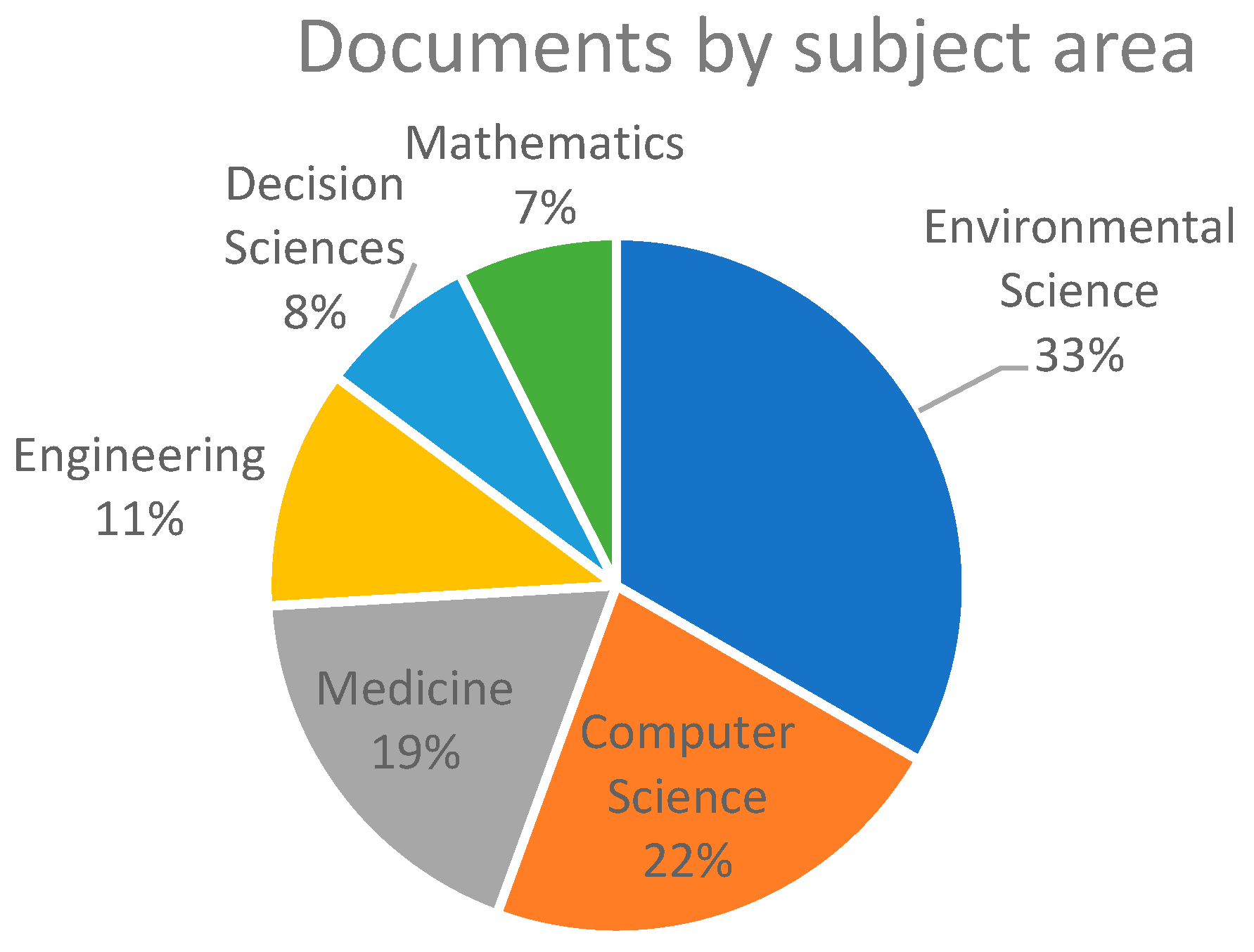
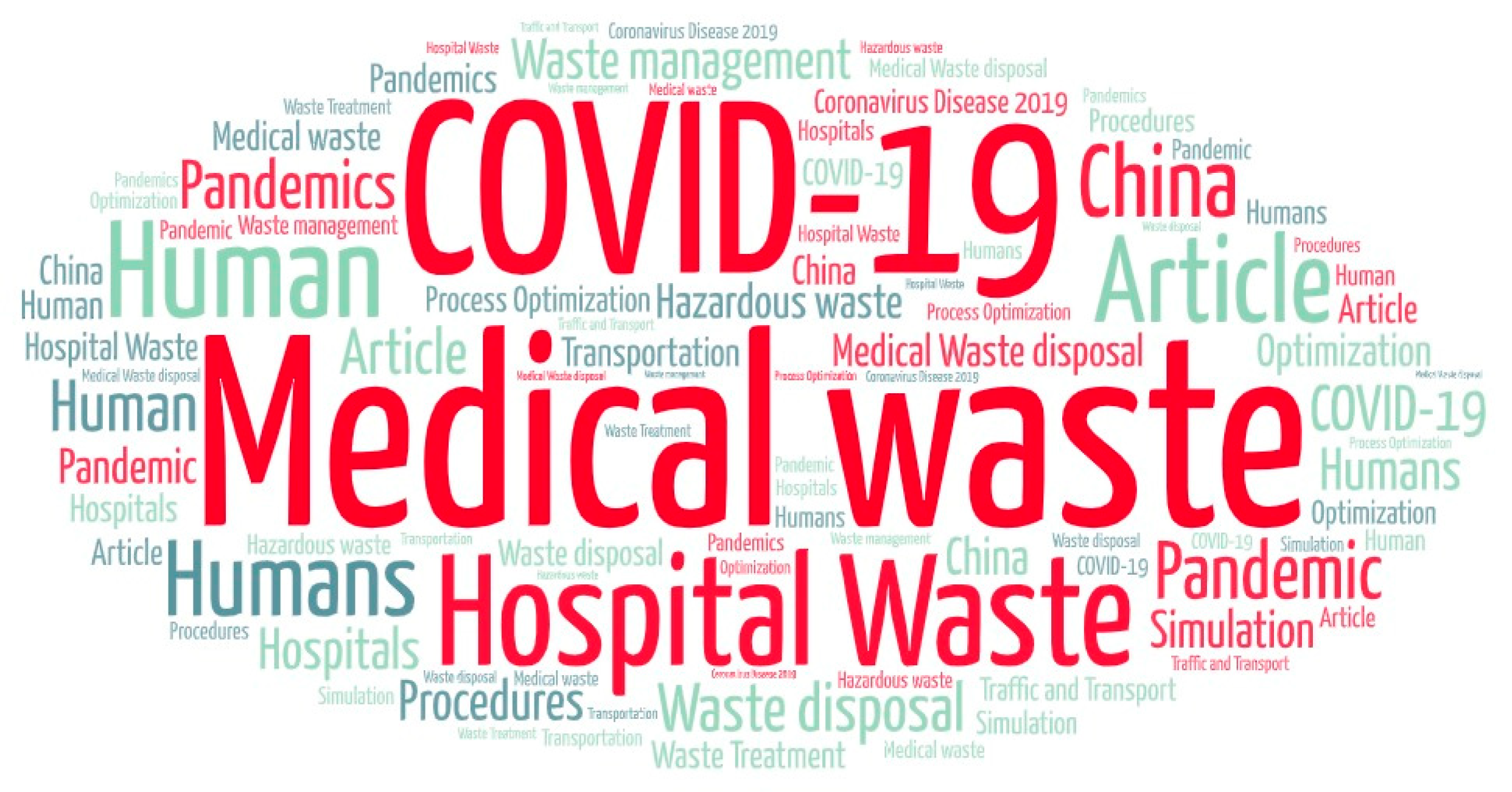
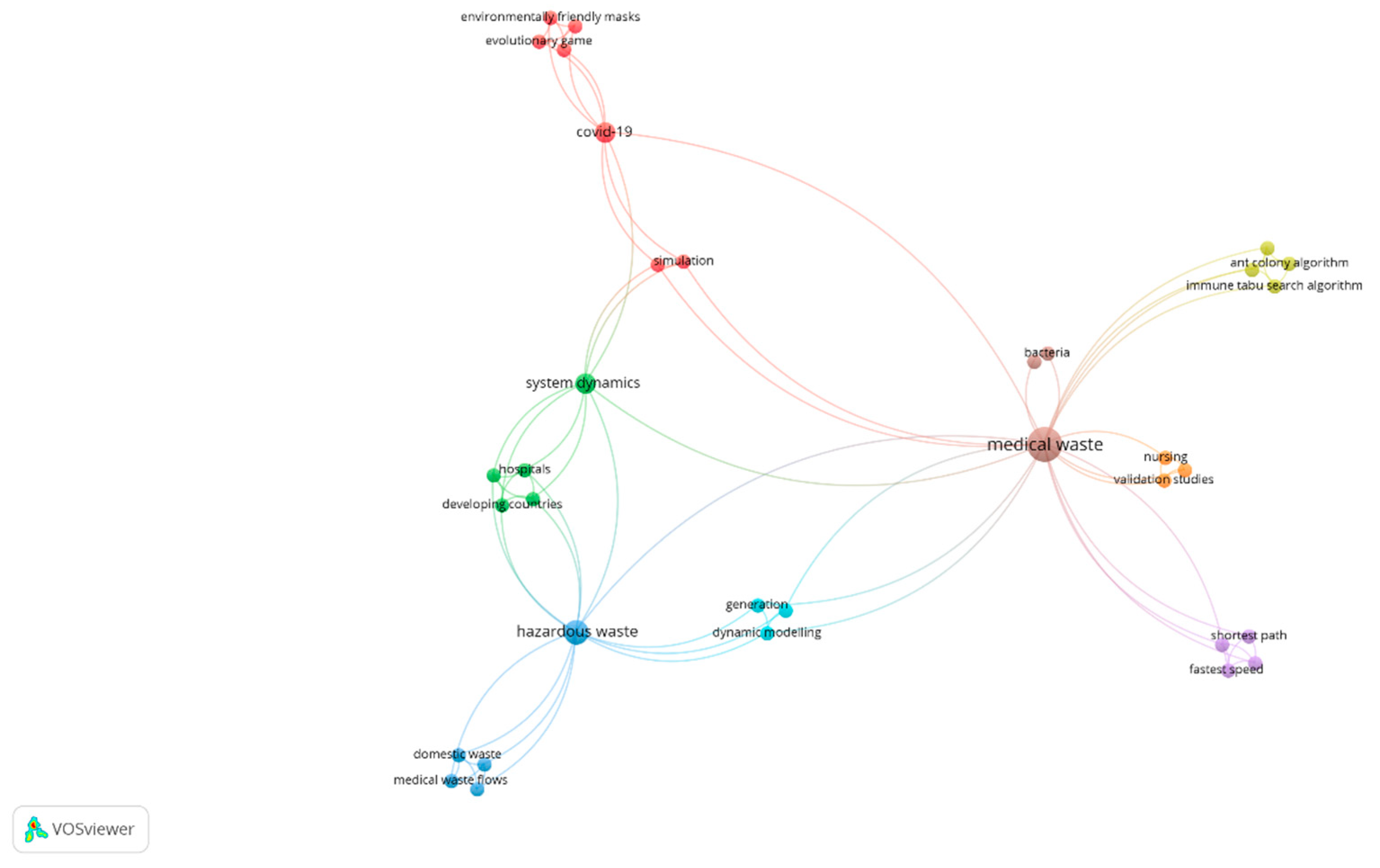
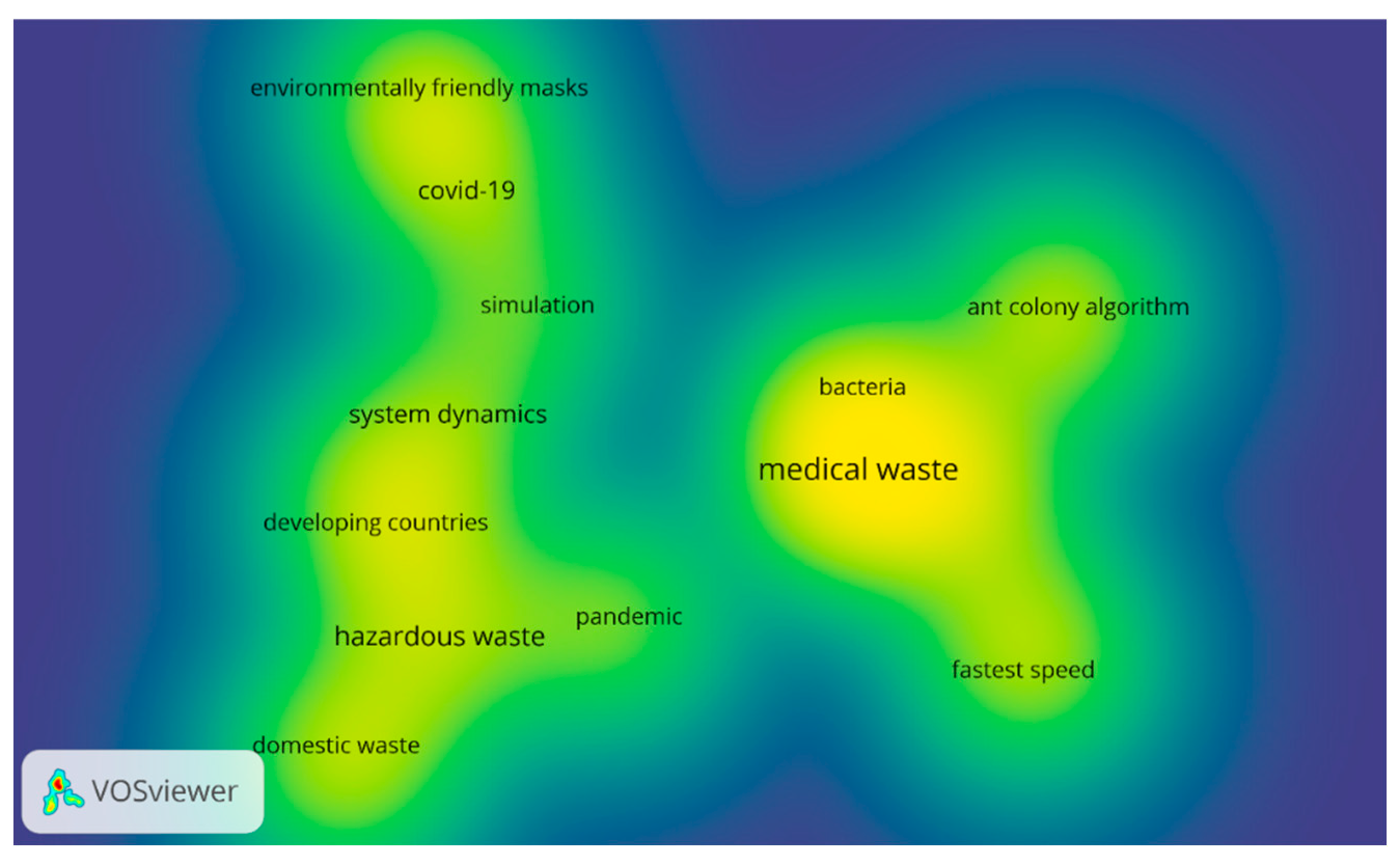
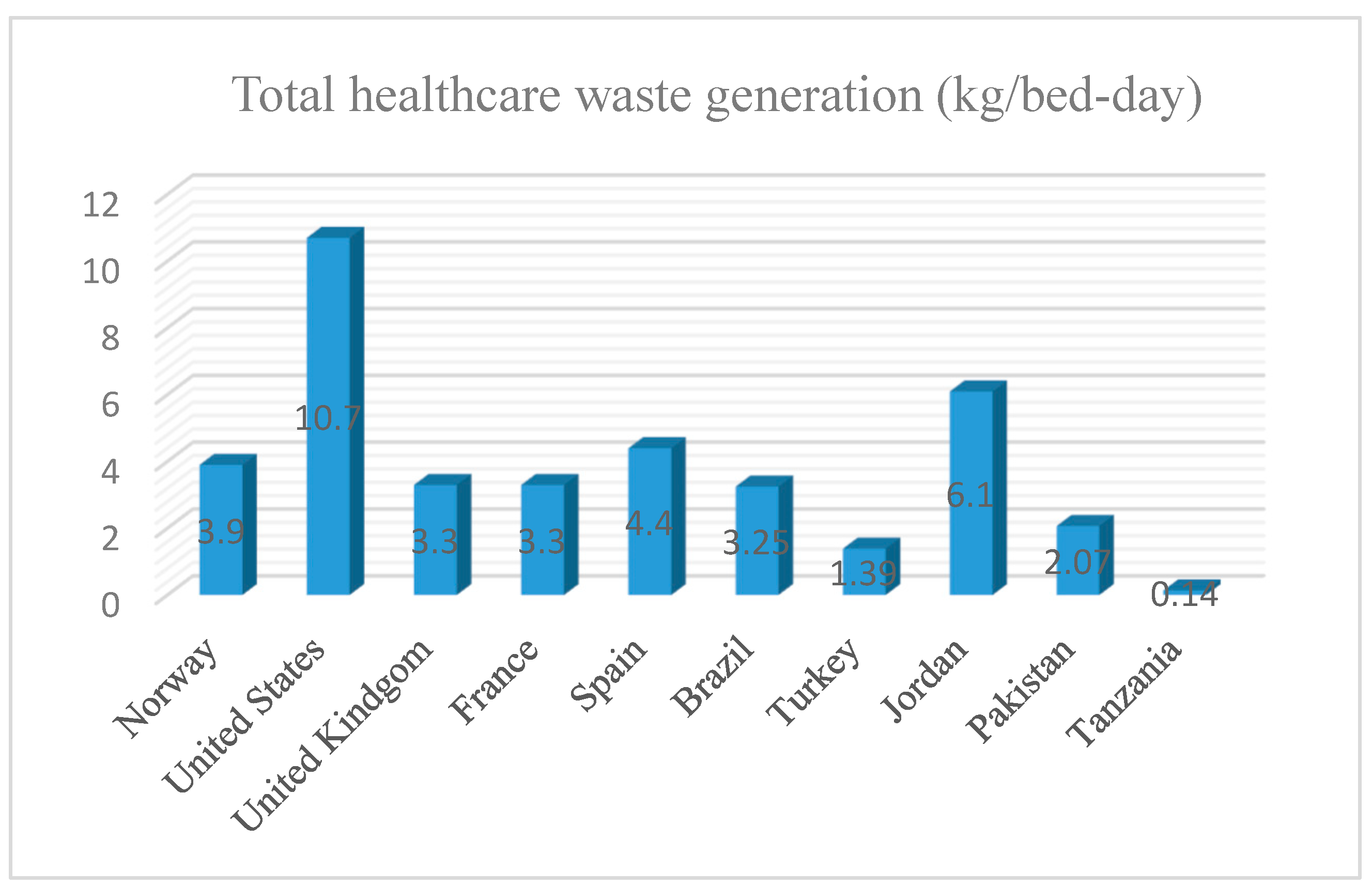
| Scopus | ScienceDirect |
|---|---|
| 97 | 21 |
| Inclusion Criteria | Exclusion Criteria |
|---|---|
| All documents dated since 2010 | Non-English; Vaguely related to the theme |
| Title | Year | Main Objective, Methodology and Results | Nº of Citations (Scopus) |
|---|---|---|---|
| Optimizing Waste Management Collaboration Processes Using Hybrid Modelling [43] | 2024 | This work proposes hybrid modeling with integrated discrete-event simulation, agent-based simulation and improved MCDC methods in order to optimize the number of workers with the minimum asynchronous waiting time and cost based on waste management process data. The results indicate that hybrid modelling can minimize 74% of the minimum asynchronous waiting time and 31% of the activity cost compared to the actual model under an overload condition. | 0 |
| Research on transportation management model of COVID-19 medical waste: a case study in Beijing, China [44] | 2023 | This article implements a transport route optimization model using Anylogic simulation software in the regional distribution of 118 tertiary hospitals and two large medical waste disposal plants in Beijing. This study enabled the analysis of two modes of hospital waste transportation (the most costly route and the fastest speed), contributing to the better management of hospital waste transportation. | 0 |
| Discrete cuckoo search algorithm in scheduling dynamic route of medical and non-medical waste transportation at regional-based health facilities during the COVID-19 pandemic [45] | 2023 | This work designs waste transport routes in such a way as to minimize the costs and distance using the Discrete Cuckoo Search algorithm. In this paper, a clustering process was carried out and then the algorithm was implemented. Finally, a comparison was made with other algorithms. The results reveal that the Discrete Cuckoo search algorithm had better results than the Artificial Bee Colony (ABC) and Particle Swarm Optimization (PSO). | 0 |
| Designing reverse logistics network for healthcare waste management considering epidemic disruptions under uncertainty [46] | 2023 | The main aim of this study was to create a reverse logistics network to manage healthcare waste. The model minimizes the total cost and the risk to the population. A simulation algorithm using probabilistic distribution functions was implemented in order to generate data of different sizes and to evaluate the proposed model. | 3 |
| Conceptual design and simulation study of an autonomous indoor medical waste collection robot [47] | 2023 | The purpose of this article was to describe a project for a mobile robot whose tasks consist of intelligently identifying and collecting a group of hospital wastes. To achieve this, several simulations were created using the Robot Operating System and the Gazebo simulator. A LIDAR sensor was also implemented to monitor the robot’s surroundings and enable autonomous navigation. | 1 |
| The Influence of Pandemic COVID-19 on Hazardous Waste Management from Hospital A in Yogyakarta [48] | 2023 | The main objective of this study was to analyze the management of hazardous waste during the pandemic in a hospital in Yogyakarta. For this purpose, dynamic systems modeling was used for the technical, financial and environmental aspects using Vensim PLE with a stock–flow diagram. Dynamic system modeling applications were used, considering technical, financial and environmental aspects, using Vensim PLE with the stock–flow diagram. The results showed that there was an increase in the production and transportation of waste during the pandemic, reaching 9.36%. In total, 11,756 kg/year of waste was produced and the waste transportation costs increased to IDR 109,860,000/year. | 0 |
| Green Transformation of Anti-Epidemic Supplies in the Post-Pandemic Era: An Evolutionary Approach [49] | 2022 | This work investigated a method of effectively guiding the green transformation of medical waste concerning the economic interests of medical institutions and manufacturers of masks. In this paper, a dynamic system model was implemented for the simulation analysis. | 4 |
| Optimizing Time and Cost Activity based on Discrete Event Simulation with Multi-Objective Optimization Method by Ratio Analysis (MOORA) [50] | 2022 | The main purpose of this work was to determine the number of medical resources in different proportions of time and cost in an attempt to identify the relationship between cost, time and the number of workers involved in the waste management system of a hospital in East Java in Indonesia, through a combination of Discrete Event Simulation and MOORA. The results showed that less incoming waste requires fewer workers than in situations with more waste. | 0 |
| Research on optimization of healthcare waste management system based on green governance principle in the COVID-19 pandemic [51] | 2021 | This article analyzes the principles of green governance and highlights the problems that exist in the healthcare waste management system in Wuhan. The work proposes a hybrid model combining the Genetic Algorithm (GA) and Ant Colony Algorithm (ACO) to achieve hospital waste transportation optimization. Finally, this article analyzes the role of government, hospitals and communities in the process of disposing of healthcare waste and suggests guidelines for its disposal. | 15 |
| A comprehensive waste management simulation model for the assessment of waste segregation in the health sector [52] | 2021 | The main goal of this study was to evaluate different levels of segregation in household waste mixed with hospital waste in the Thrace Region of Turkey. Therefore, the Stella and Vensim Simulation was implemented to evaluate medical waste flows. The results indicated a predicted increase from almost 2000 tons/year to almost 3000 tons/year in 2045. There is also the possibility of avoiding 300 tons of hospital waste per year by reducing the domestic content of hospital waste to 50%. | 1 |
| Waste Collection of Medical Items under Uncertainty Using Internet of Things and City Open Data Repositories: A Simheuristic Approach Open Access [53] | 2021 | This work explores the problem of collecting medical waste in the city of Barcelona, minimizing the total time invested by the fleet of vehicles to complete the task. Thus, the combination of multi-start biased–randomized heuristics (BRHs) with Monte Carlo Simulation allows more effective results in situations where the travel and collection time are uncertain. | 0 |
| Managing Medical Waste during COVID-19 Outbreak: A Simulation Approach [54] | 2021 | The aims of this study were to explore the strategies and policies needed to manage the amount of medical waste in Indonesia in two situations: during an outbreak such as COVID-19 and under normal conditions (no outbreak). Systems Dynamics is used in this study and helps to optimize the medical waste management system during COVID-19. | 0 |
| The design of medical waste treatment in public health center (MWT-P) for reducing total bacteria count in Banjarbaru [55] | 2020 | This study explores variations (contact time and chlorine dose variation) in the different stages of hospital waste processing in the Public Health Center of the city of Banjarbaru. This study was conducted by simulating variations. The study results indicated that the use of MWT-P decreases the number of microorganisms or bacteria in medical waste. | 2 |
| Adaptive protocol generation for group collaborative in smart medical waste transportation [56] | 2020 | This work deals with the challenge of collective decision-making between intelligent components in the transportation of medical waste by using Automated Guided Vehicle Medical Waste Transportation (AGV-MWT). | 4 |
| Path optimization of medical waste transport routes in the emergent public health event of COVID-19: A hybrid optimization algorithm based on the immune-ant colony algorithm [57] | 2020 | This article applies an immunological algorithm to establish a model for locating urban medical waste storage sites in Wuhan, China. In this work, various temporary storage points are analyzed according to the environmental impacts and evaluation criteria, using the Q-value method to allocate hospital waste vehicles and applying the immune ant colony algorithm along with the tabu search algorithm. | 28 |
| The use of discrete event simulation for optimal performance of blood banks (A case study of Al-Shifa Central Blood Bank) [58] | 2020 | The aim of this study was to satisfy the need for blood while minimizing the phenomenon of outdated blood units. Discrete Event Simulation was implemented to represent the Al-Shifa Central Blood Bank in order to enable better decision-making by analyzing the system’s behavior. | 0 |
| Solving a routing problem of collect infectious healthcare waste with stochastic demand: Case of Sfax governorate in Tunisia [59] | 2020 | This work analyzes approaches that help municipalities make decisions on how to implement an appropriate system for transporting infectious healthcare waste. Two approaches were proposed: (1) a combination of the exact method with Monte Carlo simulation, and (2) a combination of the same simulation tools with those proposed by Clarke and Wright (C&W); this made it possible to support decision-making in the creation of a transport system for infectious medical waste. | 0 |
| An optimization model for collection, haul, transfer, treatment and disposal of infectious medical waste: Application to a Greek region [60] | 2017 | This paper presents an optimization model that minimizes the cost of a system for collecting, transporting, transferring, treating and disposing of infectious hospital waste (optimal location of treatment facilities and transfer stations, their design capacities (t/d), the number and capacity of all waste collection sites, and transportation and transfer vehicles and their optimal transportation route). The model was implemented in the East Macedonia–Thrace region of Greece Two software packages were used: Evolver, which is based on the use of genetic algorithms, and Crystal Ball, which is based on Monte Carlo simulation. | 74 |
| A system dynamics approach for hospital waste management in a city in a developing country: the case of Nablus, Palestine [61] | 2016 | This study focuses on the development of a system dynamics simulation model for use as a predictive tool in hospital waste management for better decision-making. Through this model, it is possible to analyze different future scenarios of hospital waste situations in Palestine. The model developed allows for a comparison of the total amount of waste produced between different hospitals and to predict the generation of more waste, as well as treatment costs. | 22 |
| Scenario for a simulation of health services’ waste: A methodological study [62] | 2016 | This methodological study aims to validate the different contents of a scenario to be used in the form of a healthcare waste management simulation. Based on the scenario implemented and improved by experts and students, it will be possible to train healthcare professionals in different contexts. | 4 |
| Cluster 1 | Cluster 2 | Cluster 3 | Cluster 4 |
|---|---|---|---|
| COVID-19; Environmentally friendly masks; Evolutionary game; Government regulation; Green Transformation; Simulation; Waste generation | Developing countries; Generation rate; Hospitals; Palestine; System Dynamics | Domestic waste; Hazardous waste; Medical waste flows; Simulation modeling; System parameters | Ant colony algorithm; Immune tabu search algorithm; Path Optimization; Transit storage |
| Cluster 5 | Cluster 6 | Cluster 7 | Cluster 8 |
| Fastest speed; Shortest path; Tertiary hospital; Transportation | Dynamic modelling; Generation; Pandemic | Nursing; Simulation training; Validation studies | Bacteria; Medical waste; Treatment plan |
| Country | WHO Ranking of Health System Performance |
|---|---|
| Norway | 11 |
| United States | 37 |
| United Kingdom | 18 |
| France | 1 |
| Spain | 7 |
| Brazil | 125 |
| Turkey | 70 |
| Jordan | 83 |
| Pakistan | 122 |
| Tanzania | 156 |
Disclaimer/Publisher’s Note: The statements, opinions and data contained in all publications are solely those of the individual author(s) and contributor(s) and not of MDPI and/or the editor(s). MDPI and/or the editor(s) disclaim responsibility for any injury to people or property resulting from any ideas, methods, instructions or products referred to in the content. |
© 2024 by the authors. Licensee MDPI, Basel, Switzerland. This article is an open access article distributed under the terms and conditions of the Creative Commons Attribution (CC BY) license (https://creativecommons.org/licenses/by/4.0/).
Share and Cite
Ferreira, A.; Ramos, A.L.; Ferreira, J.V.; Ferreira, L.P. Simulation of Hospital Waste Supply Chain in the Context of Industry 4.0—A Systematic Literature Review. Sustainability 2024, 16, 6187. https://doi.org/10.3390/su16146187
Ferreira A, Ramos AL, Ferreira JV, Ferreira LP. Simulation of Hospital Waste Supply Chain in the Context of Industry 4.0—A Systematic Literature Review. Sustainability. 2024; 16(14):6187. https://doi.org/10.3390/su16146187
Chicago/Turabian StyleFerreira, André, Ana L. Ramos, José V. Ferreira, and Luís P. Ferreira. 2024. "Simulation of Hospital Waste Supply Chain in the Context of Industry 4.0—A Systematic Literature Review" Sustainability 16, no. 14: 6187. https://doi.org/10.3390/su16146187
APA StyleFerreira, A., Ramos, A. L., Ferreira, J. V., & Ferreira, L. P. (2024). Simulation of Hospital Waste Supply Chain in the Context of Industry 4.0—A Systematic Literature Review. Sustainability, 16(14), 6187. https://doi.org/10.3390/su16146187












